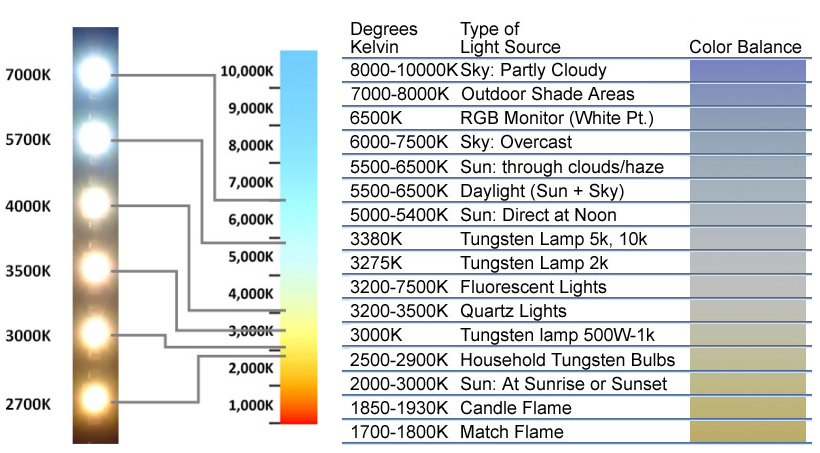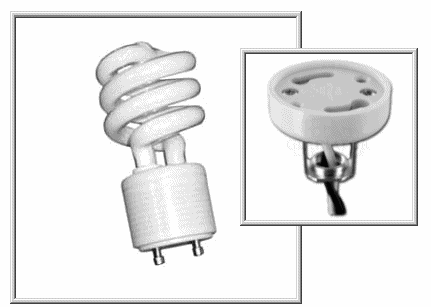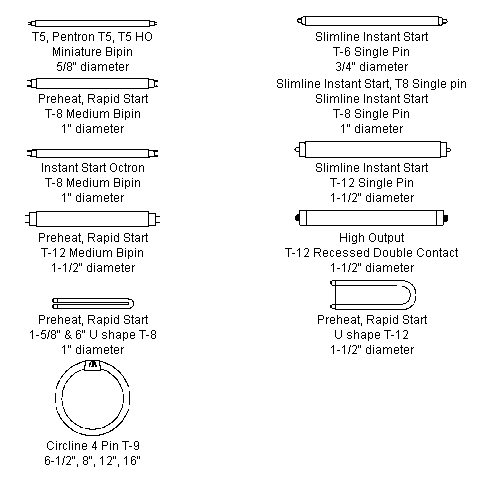The Consumer's Guide to Light Bulbs
When purchasing light bulbs, and consideration when purchasing light fixtures as to what bulbs they use, the consumer needs to be familiar with three very basic principles.
- Light Output
- Color Temperature
- Luminous Efficacy
The consumer will need to know what socket type the bulb uses. Some common socket types are:
- E26/E27 Edison Screw
- GU24 Bayonet
- ....
 Learn more... |
Light Bulb Luminous Efficacy
Luminous efficacy is a measure of how well a light source produces visible light. It is the ratio of luminous flux to power. Luminous flux can be defined as the measure of the perceived power of light. The luminous efficacy of a light bulb is a measure of the efficiency with which the light bulb provides visible light from electricity.
Artificial light sources are usually evaluated in terms of luminous efficacy of a source, also sometimes called overall luminous efficacy. The overall luminous efficacy is a measure of the efficiency of the device with the output adjusted to account for the spectral response curve. When expressed in dimensionless form this value may be called overall luminous efficiency, wall-plug luminous efficiency, or simply the lighting efficiency.
The efficacy is effectiveness of the light bulb to product light. The efficiency of the bulb is a measure of how well it produces "visible" light for how many watts consumed. It is the ratio of the visible light delivered for how much energy is supplied.
The Watts for Light Output Consumer Misnomer
The measure of a light bulb's perceived brightness, the luminous out, using the old Watts standard is not wrong. Brightness is a description of light output, which is measured in lumens. Light bulb brightness described by watts should never have been used in the market. Now manufacturers are producing bulbs that are many times more efficient. Efficacy is about the brightness, whereas efficiency is about how much energy is wasted in producing the light output.
Watts is a measurement of the amount of energy required to product light. The higher the watts the more your electric bill goes up. You want a bulb that produces the brightest possible light using the fewest watts. When purchasing a light bulb, you should be considering the lumens so that you can know exactly how bright the light bulb will be.
Tungsten Incandescent Watts to Lumens
Here is a cross-reference based on the light output of old tungsten incandescent light bulb.
- 40-watt incandescent bulb = 450 lumens
- 60-watt incandescent bulb = 800 lumens
- 75-watt incandescent bulb = 1100 lumens
- 100-watt incandescent bulb = 1600 lumens
- 150-watt incandescent bulb = 2600 lumens
To save energy, find the bulbs with the lumens you need, and then choose the one with the lowest wattage. Tungsten Incandescent Light Bulbs are slightly less efficient than Halogen Light Bulbs. Fluorescent Light Technology is more efficient than incandescent and halogen. Considerably more efficient than fluorescent lighting, including CFL (Compact Florescent Lights) are LED Light Bulbs. Modern LED light bulbs product the most lumens for the fewest watts.
Besides considering the brightness and energy consumption of a light bulb you should also consider the Light Color Temperature of the blub. Although color temperature does not have a significant impact on how efficient the bulb produces light, it does have an impact on your perception of what kind of light the bulb produces.
Incandescent Light Bulbs
Incandescent lamps are nearly pure resistive loads with a power factor of 1. This means the actual power consumed (in watts) and the apparent power (in volt-amperes) are equal. The actual resistance of the filament is temperature dependent. The cold resistance of tungsten filament lmaps is about 1/15 the resistance when the lamp is lit. For example, a 100 watt, 120 volt lamp has a resistance of 144 Ω when lit, but the cold resistance is much lower (about 9.5 ohms) [31]. Since incandescent lamps are resistive loads, simple triac dimmers can be used to control brightness. Electrical contacts may carry a "T" rating symbol indicating that they are designed to control circuits with the high inrush current characteristic of tungsten lamps. For a 100-watt 120 volt general service lamp, the current stabilizes in about 0.10 seconds, and the lamp reaches 90% of its full brightness after about 0.13 seconds.
Power
| Power (W) | Output (lm) | Efficacy (lm/W) |
|---|---|---|
| 5 | 25 | 5 |
| 15 | 110 | 7.3 |
| 25 | 200 | 8.0 |
| 35 | 350 | 10.3 |
| 40 | 500 | 12.5 |
| 50 | 700 | 13.5 |
| 55 | 800 | 14.2 |
| 60 | 850 | 14.5 |
| 65 | 1000 | 15.0 |
| 70 | 1100 | 15.7 |
| 75 | 1200 | 16.0 |
| 90 | 1450 | 16.1 |
| 95 | 1600 | 16.8 |
| 100 | 1700 | 17.0 |
| 135 | 2350 | 17.4 |
| 150 | 2850 | 19.0 |
| 200 | 3900 | 19.5 |
| 300 | 6200 | 20.7 |
Light Color Temperature
Color temperature is a measure of a light source radiating color when illuminated, and is measured in degrees Kelvin. The higher the number, the whiter and then bluer, the color.
"Temperature" in this context refers to "appearance" rather than a thermal property for the touch sense. It is simply a way to describe the color characteristics of light, usually either warm (yellowish) or cool (bluish.
The color temperature of a light source is the ideal black-body radiator that radiates light of comparable hue to that of the light source. When a so called black body radiator such as a lamp filament is heated, the filament will begin to glow. As the temperature of the filament increases the color of the light emitted will shift from one end of the spectrum progressively to the other. Color temperatures over 5,000K are called cool colors (bluish white), while lower color temperatures (2,700–3,000 K) are called warm colors (yellowish white through red). This relation, however, is a psychological one in contrast to the physical relation implied by Wien's displacement law, according to which the spectral peak is shifted towards shorter wavelengths (resulting in a more blueish white) for higher temperatures.
Some Standard Light Bulb Socket Types
E26 Edison Screw
In the designation 'Exx', 'E' stands for 'Edison' and 'xx' refers to the diameter in millimeters as measured across the peaks of the thread on the base. In Europe the designation is E27 which is nearly the exact same size.
A19 bulb with E26 base
The most commonly used A-series light bulb with an E26 base is the A19 bulb. The A19 designation refers to the width of the bulb in one-eighth inch units. When speaking about the bulb, we say A19, and the base we say E26.
The common A19 bulb is 2 3/8 inches wide, 4 3/8 inches long, and has a one inch E26 base. These bulbs were originally of the incandescent type, burning a tungsten wire filament to produce light.
GU24
The GU24 socket and base system is designed to replace the Edison socket and base in energy efficient lighting fixtures. The California Energy Commission prohibits adapters that would allow the use of screw-in bulbs on a GU24 base. This is to prevent people from using normal incandescent bulbs.
The GU24 base has two dual-diameter pins. The smaller portion has a diameter of 3.4mm (0.13") and the larger portion has a diameter of 5mm (0.2").
A19 bulb with GU24 base
As explained in Common Residential Light Bulb Socket Types in North America the shape of the bulb as described as A19 represents the common shape that most people are familiar with. The A19 bulb was traditionally available with the E26 Edison Screw base. Now as a result of new Government regulations, it is common to see the A19 bulb with the GU24 socket base system.
Other
 Learn more... |
Fluorescent Lighting
Fluorescent Light: A gas-discharge lamp that uses electricity to excite mercury vapor, producing short-wave ultraviolet light that then causes a phosphor to fluoresce, resulting in visible light emission. Fluorescent lights require a ballast to regulate the flow of power through the bulb.
There is phosphor inside the fluorescent light bulb tube that, when excited, converts ultraviolet radiation into visible light. The chemical composition of the phosphor determines the color temperature of the light emitted by the bulb.
Compact Fluorescent Light Bulbs (CFL): A CFL can use less than one-third the electricity of incandescent bulbs of equivalent brightness and last up to nine years. CFLs contain an average of 5 milligrams of mercury, which increases the bulb’s efficiency, posing a new toxic threat to the environment.
Legislation: The Energy Independence and Security Act of 2007 (the “Energy Bill”), signed by the President on December 18, 2007 requires all light bulbs use 30% less energy than today’s incandescent bulbs by 2012 to 2014. The phase-out will start with 100-watt bulbs in January 2012 and end with 40-watt bulbs in January 2014. By 2020, a Tier 2 would become effective which requires all bulbs to be at least 70% more efficient (effectively equal to today’s CFLs). In California, a legislator recently proposed banning the sale of incandescent light bulbs in the state by 2012.
Cold-Weather Ballast: Compact fluorescent light bulbs require a ballast to regulate the voltage of the electricity that is applied to the gas inside the lamp. Below-freezing weather can adversely affect the electronic components in these ballasts, causing most compact fluorescent bulbs to appear dim in cold weather. Cold-weather ballasts compensate for this problem and keep the bulb glowing brightly, even in weather as cold as -10°F (-23°C).
Fluorescent Tube Light Bulbs
T5
The T5 lamp is an increasingly popular development in fluorescent lighting. In 1995, T5 fluorescent lamps entered the market in the United States. Today, the three major lamps manufacturers aggressively market T5 lamps. Luminaire manufacturers create innovatively designed compact luminaires using up-to-date optical materials. Recently, lighting designers have begun to specify such T5 luminaires for high-end new construction. The marketing and innovative design of T5 systems have left many end users wondering whether they should consider T5 luminaires instead of T8 luminaires, especially in new construction and retrofitting of T12 magnetic systems. End users are confused by the 10°C (18°F) difference in optimal temperature and the small difference in system efficacy between T5 and T8 systems. This section focuses on physical characteristics of T5 systems compared to T8 systems. This publication discusses T5 systems—including T5 lamps, ballasts, and luminaires—to answer commonly asked questions.
T5 fluorescent light bulbs are a very small linear type of fluorescent that are used in many applications including under cabinet, task lighting and any place where there is a small space. They are very trim they are only 5/8 of an inch in diameter and have two pins on each end. These shouldn't be confused with the newer version T5 lamps which are out of the market for energy efficiency. These have been on the market for a few decades and are used not for general lighting the specific lighting applications. In other words, you wouldn't use these for overhead lighting, that's the other kind of T5 fluorescent lamp. These come in cool white, warm white and sometimes in the daylight version. T5 fluorescent light bulbs can be identified by the code on the bulb.
T4
Even thinner than the T5 bulb, the T4 bulb have more limited lengths. They are commonly used for under cabinet lighting such as the Westek FA201 which uses a Westek FA200 T4 fluorescent bulb.
Halogen Lighting
A halogen lamp is an incandescent lamp in which a tungsten filament is sealed into a compact transparent envelope filled with an inert gas, plus a small amount of halogen such as iodine or bromine. They can last two or three times longer than regular bulbs because they are filled with chemically active halogen gases that preserve the filament.
The filament of an ordinary light bulb burns out because atoms of tungsten evaporate from its surface, so that it becomes thinner and thinner until it breaks. The evaporated tungsten is deposited on the inside surface of the bulb, where it forms a dark deposit.
The gas inside a halogen bulb combines with the tungsten atoms including those that have been deposited on the glass. When the combined molecules touch the hot filament, the tungsten is redeposited there, and the gas is released to repeat the process.
A halogen bulb is often 10 to 20 percent more efficient than an ordinary incandescent bulb of similar voltage, wattage, and life expectancy. Halogen bulbs may also have two to three times as long a lifetime as ordinary bulbs, sometimes also with an improvement in efficiency of up to 10 percent.
Halogen lamps get hotter than regular incandescent lamps because the heat is concentrated on a smaller envelope surface, and because the surface is closer to the filament. This high temperature is essential to their operation. Because the halogen lamp operates at very high temperatures, it can pose fire and burn hazards.
Common Halogen Bulb Types Commercial and Residential
- Halogen Reflector Floods
- Single End Halogen
- Double End Halogen
- Halogen Bipin light bulbs
- MR8 Halogen
- MR11 Halogen
- MR16 Halogen
- MR20 Halogen
- MB Halogen
- AR Halogen and ALR Halogen
Double End Halogen
Double Ended Recessed Contact (RSC Base) Halogen Light Bulbs. Do not be confused. The "J" type and "T" type designation are one and the same.
- Base: R7S
- Shape: T3
sub-types:
- Double End Halogen Short - 3 Inch (50 to 300 Watt) (??? - 5000 lumens) 78mm
- Double End Halogen Long - 4 5/8 Inch
- Double End Halogen - 10 Inch
- Pin Blade Halogen
All Wiki Lighting Documentation
Category Index: Category:Lighting


